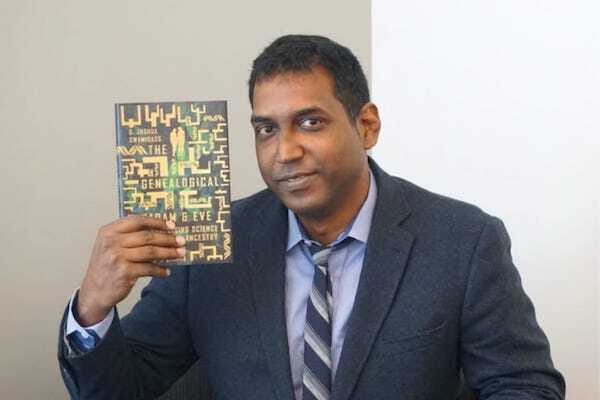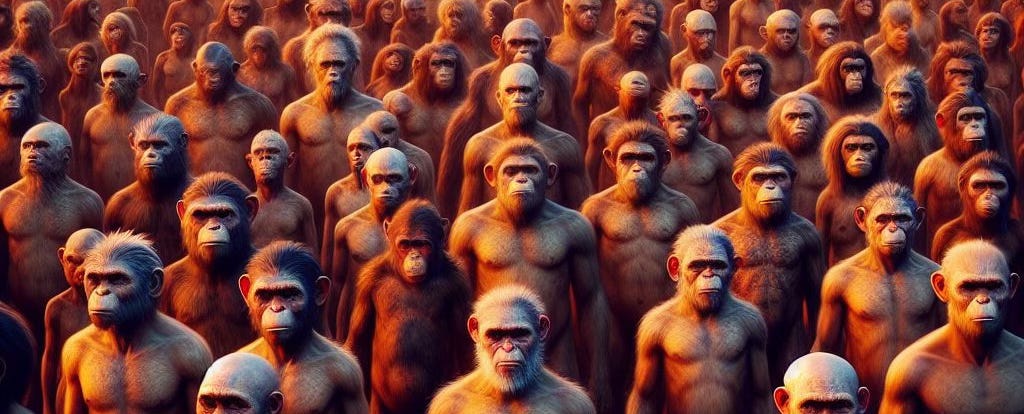A while back, I did an interview with Joshua Swamidass to discuss his theory of human evolution and creation outlined in his book, The Genealogical Adam and Eve.
Like many other Christians (and for the record I do consider Josh a brother in Christ), Swamidass feels the need to syncretize his belief in Darwin’s theory of animal to human evolution with his faith in the Bible. I won’t take a deep dive into the science of his theory in this post, but I will try and correct a few misconceptions about his theory. Nothing in this post is a defeater for Swamidass’ theory. My goal is to bring clarity. Like any good reader, I want to define our terms so that we are all having a clear discussion about the same well-defined ideas. So let me summarize for you what his theory states and then how specific terms are used.
Who are The Genealogical Adam and Eve?
Swamidass accepts animal to human evolution as the product of natural selection, at the same time he does not deny that God may have miraculously intervened at certain times in history. He does not appear to be a naturalist. However, it is evident from Swamidass’ work that like most advocates of theistic evolution, evolutionary biology remains his magisterial source of knowledge about human origins and the starting point for rethinking his theology. In his 2021 interview with Tim Hull (who at the time accepted Swamidass’ model) Swamidass makes this very point.
“I do think the right way to approach this is to understand that it’s not really about the answers we have it’s about the questions we bring. Sure and if you if you look at the Christian tradition um yeah there are quote-un-quote answers but what’s been far more interesting for me um as a scientist studying historical theology is to understand theology not as uh you know like a wooden statement of things that we must believe or not but rather as a living conversation that’s continuous of the past and continues to this point and so we have an opportunity to like join a conversation about some really grand questions [22:58–23:31].”
How broadly Swamidass takes this “living conversation” is unclear. Does it apply to other theological beliefs such as the resurrection, Jonah, the miracles of Jesus, etc..? Since Hull did not clarify the point it is impossible to say. However, the quote above does fit well with what I read in The Genealogical Adam and Eve. Swamidass offers readers what he frames as a new and revolutionary paradigm for reinterpreting the traditional theology of human origins that meets the challenges set forth by science.1
For Swamidass, animal to human evolution is a scientific fact that does not eliminate the possibility that less than 10,000 years ago God miraculously created two humans called Adam and Eve.
Listen here as Swamidass makes his case on episode 357 of the Naked Bible Podcast hosted by the late Mike Heiser.
Swamidass believes that the children of Adam and Eve then reproduced with the biologically indistinguishable humans who already existed and who had evolved outside the Garden of Eden from ape-like hominids. Swamidass writes:
“Much like the Virgin Birth of Jesus, there is no evidence for or against the de novo creation of Adam and Eve, ancestors of us all, a historical couple who lived recently in the Middle East.”2
Note Swamidass’ novel use of the term ancestor. Contra Genesis 3:20, Swamidass believes that the truth of animal to human evolution eliminates Adam as the first actual man and excludes Eve as the biological “mother of all the living.” Adam and Eve are not the “parents” of all humans, but do became part of the ancestral line of modern humans after many thousands of years of sexual congress with the evolved humans from outside the Garden.
The Bible, therefore, reveals only the origins of what Swamidass calls “textual humans” who eventually became the genealogical, but not genetic, ancestors of the existing human population.
That is, all humans today are statistically related to this special couple, but not in any meaningfully biological sense. Adam and Eve are not the biological progenitors or first parents of all humans in history. Swamidass summarizes his theory as follows:
It appears that our ancestors share common ancestors with the great apes and arise as a large population, never dipping in size to a single couple. Without contradicting the findings of genetic science, genealogical science gives a different answer to the question. It is likely that there have been many individuals, and potentially couples, across the globe who are each individually genealogical ancestors of all those alive when recorded history began. These ancestors stretch from our distant past to very recently in our history. Consistent with the genetic and archeological evidence, therefore, it is possible that God could have chosen, or specially created, one of these couples for a special role.3
Now, given this summary, here are a few key points that need to be a part of our conversation about human origins.
Swamidass’ Theory is Polygenism not Monogenism
Swamidass goes to great lengths in his book to isolate his theory from historic polygenism and align himself with monogenism. To those unfamiliar, I have spent the last several years studying these views as part of my PhD and without a doubt there are a wide range of theories that fit within these camps (way too many to address in this post). But it is fair to say that historically the common ground for the polygenists was a belief the different human races originated from distinct sets of ancestors. The common ground for the monogenists was a belief that the different human races originated from a common ancestral group. Now, despite his claims to monogenism, I would argue that Swamidass’ theory, at best, blurs the lines. But, I also think his view comes far closer to polygenism than he would like. Why? For two simple reasons.
He posits two different origin stories for humans: one group of humans who evolved outside the garden and the second group (Adam and Eve) who God (may have) created inside the garden. This is poly (two) genism (origins) for humans.
He posits that humans existed prior to Adam… that is by definition pre-Adamism. To be fair, this view of humans living prior to Adam is common to both monogenists and polygenists. Both had roots in pre-Adamism. However, in concert with the first point I conclude that his theory fits more naturally with historic polygenism.
Now, Swamidass defends his view as a form of monogenism this way:
“Throughout this book, I use the phrase “people outside the Garden” and emphasize that they are a long-extinct category of people, who are no longer with us. This is also why I oppose rehabilitating “polygenesis” as a literal term, and why I reject “Pre-Adamism,” even as I suggest there were people on earth before Adam and Eve. Scientists reject polygenesis as it is currently defined (130).”
So although he believes that humans existed prior to Adam, he does not want to be associate with pre-Adamites (and rightly so since most all were racist). And although he posits two distinct origins for humans, he does not want to be associated with polygenism. So on the one hand Swamidass wants to affirm the consensus science of monogenism, but posits a theory that aligns with polygenism.
Now is this connection to polygenism some kind of defeater for Swamidass’ theory? No. But it does show how Swamidass tends to redefine terms and beg the question in order to reach the conclusion he wants to reach.
Swamidass’ Theory is a Mathematical Shell Game
We have all seen the shell game played out on TV and movies. There is some street hustler who has three shells and one ball. He places the ball under one shell and shuffles them around. If you want to win the game, you have to pick the shell that conceals the ball. But we all know that you can’t really win the game. Why? Because it’s a game of misdirection. In fact, the ball is not really under any of the three shells. It is hidden in the palm of the hustler’s hand ready to be placed anywhere he likes. I don’t mean to call Swamidass a hustler (that takes my analogy too far), but I do think he is playing the shell game.
I think this shell game is a fair analogy to Swamidass’s theory of human origins because Swamidass hides the ball of “ancestry” behind the many shells of population genetics.
When the Apostle Paul says that Adam and Eve are the ancestors of us all, he means something very different than does Swamidass. And while this claim that the ball is somewhere under the shells may be statistically meaningful, in practical terms it is meaningless. In his book, Is Science Racist?, Jonathan Marks raises this very point. Not directly about Swamidass, but about how folks play the shell game of “ancestry” using mathematical models:
“Demographic modelers have shown that one only has to go back as far as the Neolithic, 10,000 years ago, to be mathematically fairly certain that everyone alive today is drawn from the same pool of ancestors. That is, of the people on earth 10,000 years ago, any particular person was the ancestor of nobody alive today or of everybody alive today; nobody back then was the ancestor of only some people alive today. For modern people, ancestry that far back in time differs only quantitatively, not qualitatively [p. 79, emphasis mine].”
In other words, the claim that Adam and Eve are our ancestors is a quantitative fact, but one that lacks quantitative substance.
Marks goes on to make this striking—and I think accurate—point about why this mathematical shell game is so popular:
“What is for sale is neither science nor facts of nature, but a contrived feeling of connection to others, and to a mythic history. Ultimately, population genetic data simply lend themselves quite readily to reification, in which a statistical population becomes confused with a natural population.”
Swamidass theory is an interesting math problem that makes us feel like we are connected to some ancient couple. But even if the math is right, it is still only a mathematical model that tells us nothing about actual human origins or ancestry.
Given Swamidass’ theory, the relevant conclusion is that modern humans aren’t just related to the single couple “Adam and Eve” (who may or may not have been created 10,000 years ago) but related to every couple in the Middle East from 10,000 years ago. That is hardly a claim that fits with the Genesis story of Adam as the first man and Eve as the mother of every human. But since belief in an historic Adam and Eve is now safely hidden beneath an infinite number of metaphorical shells, many Christians are happy to believe that their theology is protected from scientific falsification or validation.
Even Swamidass Does Not Argue his Theory is True
Honestly, it seems odd to me that Swamidass does not take a firm position on the historical truth of Adam and Eve. If you listen carefully to Swamidass speak, you will discover something very interesting. Even Swamidass does not argue that his proposal is actually true but only that it offers an idea that can never be proven false. In his desire to split the baby, he often generates confusion rather than clarity. Does he believe we are all related to Adam and Eve? Sure, why not, but he also says in his book that “we [scientists] continue to teach we arise from a large population of ancestors, not a single couple(129).” So what Swamidass really seems to argue is that humans are ancestors of BOTH large populations of evolved hominids AND possibly some specially created couple who had sex with these evolved humans. Who knows? It is all hidden in the deep past.
The appeal of a genealogical Adam and Eve to some Christians, it seems, is that Swamidass’ theory is vague enough that each reader can make it fit into their own theology.
Swamidass offers an untestable philosophical framework that allows Christians to embrace—without fear of conflict—both the so-called fact of animal to human evolution and their preferred version of the creation narrative. I realize that some people think this is a strength of Swamidass’ theory but personally I think it is a weakness. A theory that seeks to encompass every possible belief isn’t really saying much at all.

Swamidass’s Theory is Not New
The fact that Swamidass’s theory is not new is, under normal circumstances, a trivial point. After all, most of us would agree that there is truly nothing new under the sun. However, Swamidass has sold a lot of books by making the claim that his theory offers a novel and never before imagined solution to the conflict between animal to human evolution and the de novo creation of Adam and Eve. But the fact is, Swamidass is not the first and once we have an historical perspective on this theory, we can more effectively measure the value of his theory.
One recent precursor I found is from 2011. In a rather short journal article Alexander Pruss argued that animal to human evolution, “does not rule out the possibility of divine intervention in the evolutionary history of human beings designed by God.”4 While Pruss concedes that his theory is counterintuitive, he maintains that scientific theory alone cannot fully explain the origin of notable features such as intelligence. Yet even if one might possibly infer God’s intervention in the evolutionary process, he cautions, God’s actions would still remain unobservable through scientific means. Now Pruss’ theory is definitely not as extensive as what Swamidass has put together. He leaves a lot to the imagination of the reader. That said, his article does offers is a framework that fits with the narrative created by Swamidass. Pruss and Swamidass share many of the same scientific and philosophical commitments which, ironically, includes the belief that each of their thought experiments only presents a hypothetical possibility but not a necessary truth.5
Again, this is not a defeater, but clarifies that Swamidass’ theory is not primarily about the science of origins, it’s about his theology of origins.
But in all my reading of 19th and 20th century sources, I think the work of Charles White comes the closest to mirroring Swamidass. Before I summarize White’s view, let me caution that I am not claiming Swamidass’s theory carries with it the same racial implications as White’s theory. He is quite aware of this problem and addresses it in his book. I am only claiming that in terms of origin theology, White’s theory demonstrates that Swamidass’ ideas have a relevant historic context.
The English physician Charles White published his book, An Account of the Regular Gradation in Man, in 1799. Similar to the monogenists like Darwin who came less than a century later, White believed that there was a “general gradation from man through the animal race; from animal to vegetables, and through the whole vegetable system.”6
The bulk of his book, however, explored the morphological differences between the European and African peoples. Some differences, such as hair, he claimed were due solely to climate. White believed that just like dogs have different coats, “if we allow an affinity between the growth of wool and that of hair and assume that the varieties of the latter depend entirely on climate, we might expect to find the hair of negroes as long, and thicker, than that of Europeans.”7 Biological adaptation to climate could not, however, provide an exhaustive explanation for the different races of mankind. Based on his conviction that all reasonable Christians treated Genesis as allegorical, White’s conclusion was that the different races of humans were ordained by God to evolve in separate regions of the world. And, even if some Christians still wanted to believe in a literal Adam and Eve, that was okay with him. White was convinced that these two specially created persons would still have interbred with the other humans who already existed outside of the garden.8 In short, White’s theory meshes with Swamidass’ in two clear ways:
Both Swamidass and White argue that humans “evolved” from the lower apes. White certainly had not concept of natural selection so the scientific explanation is significantly different Swamidass’ science, but in principle both of these men would agree that humans have a continuity with the ape and naturally “evolved” over time.
Both Swamidass and White allow for the possibility (if people want to believe it) that Adam and Eve were specially created by God but interbred with evolved humans who lived outside the garden.
Moving out of the 18th century, as trust in the Bible waned and the influence of empiricism waxed, many Christians saw the need to reinforce polygenic theology (and ostensibly their political agenda) with the language of science. By the middle of the 19th century, many Christians had already rejected earlier views of a world created for the happiness of mankind in favor of a cruel earth history where each species was bound by the limits of the original created order.9 History often repeats itself and I would hope everyone reading along will take the time to understand and weigh Swamidass’ theory in its full context.
Conclusion
There are a lot of reason Christians should be leery about embracing Swamidass’ theory. In part because it does not fully resolve critical aspects of biblical theology such as Luke’s genealogy in chapter 3 of his Gospel and Paul’s argument in Romans 5 which creates a direct linkage to the historical persons of Adam and Eve in Genesis 3. The importance of these theological challenges must not be overlooked. That said, the point of today’s post is simply to bring some clarity to Swamidass’ theory. The genealogical Adam and Eve are not the historical Adam and Eve revealed in Scripture. If folks want to accept it as a framework for reinterpreting the biblical text, let’s go ahead and have that discussion, but let’s also make sure we are clear about what ideas his argument entails.
S. Joshua Swamidass, “A Narrative Theology of Martians, Narnians, and Neanderthals,”Cultural Encounters 14, no. 1 (Wint, 2018): 34. Although Swamidass classifies his belief as monogenic, there is the strong similarity to Isaac de La Peyrère polygenic theory of preadamites discussed in Chapter 4 starting on page 120 and the work of Charles White discussed in Chapter 3 starting on page 76.
S. Joshua Swamidass, The Genealogical Adam & Eve: The Surprising Science of Universal Ancestry (IVP Academic, 2019), 12. For a critical review of this book, see, Tim Callahan, “Leaving the Garden: A review of The Genealogical Adam and Eve: The Surprising Science of Universal Ancestry by S. Joshua Swamidass,” Skeptic 25, no. 1 (2020): 44–46.
S. Joshua Swamidass, “The Overlooked Science of Genealogical Ancestry,” Perspectives on Science and Christian Faith 70, no. 1 (March, 2018): 19. See also, Swamidass, The Genealogical Adam & Eve, 12.
Alexander R. Pruss, “A New Way to Reconcile Creation with Current Biological Science,”Proceedings of the American Catholic Philosophical Association 85 (2011): 213, http://dx.doi.org/10.5840/acpaproc20118517.
Ibid., 221.
Charles White, An Account of the Regular Gradation in Man, and in Different Animals and Vegetables; and From the Former to the Latter (London: The Poultry, 1799), 39.
Ibid., 97.
Ibid., 136–137. It is worth noting that if one removes the element of race, White’s theory bears a striking resemblance to what Joshua Swamidass has proposed in his book, The Genealogical Adam and Eve. See the discussion of his theory in the Chapter 1 section titled Theistic Evolution starting on page 33.
Paley and Paley, The works of William Paley, D. D. and an Account of the Life and Writings of the Author, 224.









